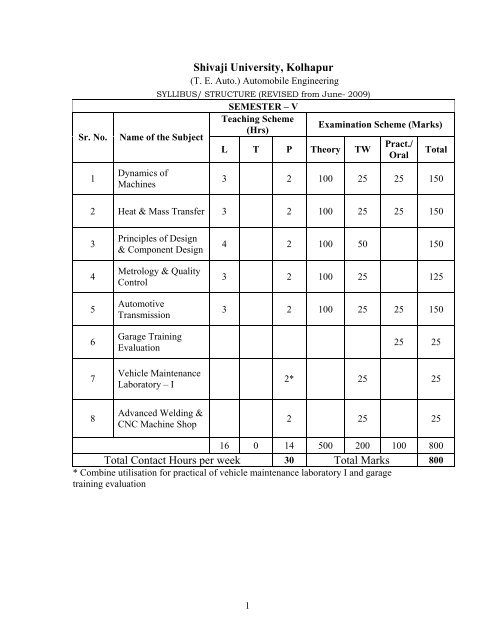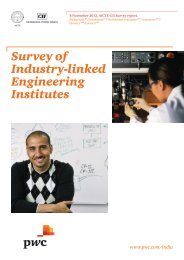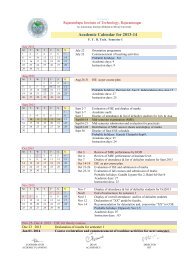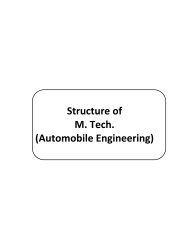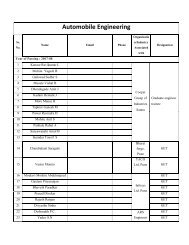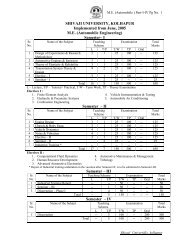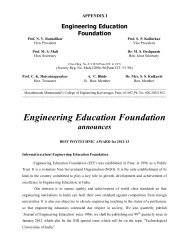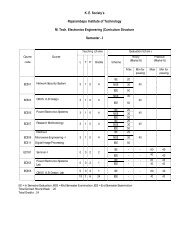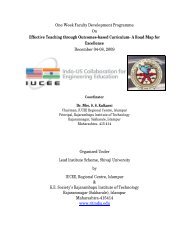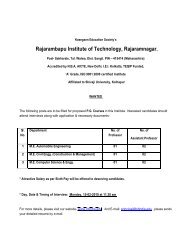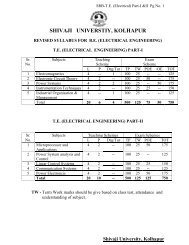Shivaji University, Kolhapur Total Contact Hours per week Total Marks
Shivaji University, Kolhapur Total Contact Hours per week Total Marks
Shivaji University, Kolhapur Total Contact Hours per week Total Marks
Create successful ePaper yourself
Turn your PDF publications into a flip-book with our unique Google optimized e-Paper software.
Sr. No.<br />
1<br />
<strong>Shivaji</strong> <strong>University</strong>, <strong>Kolhapur</strong><br />
(T. E. Auto.) Automobile Engineering<br />
SYLLIBUS/ STRUCTURE (REVISED from June- 2009)<br />
SEMESTER – V<br />
Teaching Scheme<br />
Examination Scheme (<strong>Marks</strong>)<br />
(Hrs)<br />
Name of the Subject<br />
Pract./<br />
L T P Theory TW<br />
<strong>Total</strong><br />
Oral<br />
Dynamics of<br />
Machines<br />
3 2 100 25 25 150<br />
2 Heat & Mass Transfer 3 2 100 25 25 150<br />
3<br />
4<br />
5<br />
6<br />
7<br />
Principles of Design<br />
& Component Design<br />
Metrology & Quality<br />
Control<br />
Automotive<br />
Transmission<br />
Garage Training<br />
Evaluation<br />
Vehicle Maintenance<br />
Laboratory – I<br />
4 2 100 50 150<br />
3 2 100 25 125<br />
3 2 100 25 25 150<br />
25 25<br />
2* 25 25<br />
8<br />
Advanced Welding &<br />
CNC Machine Shop<br />
2 25 25<br />
16 0 14 500 200 100 800<br />
<strong>Total</strong> <strong>Contact</strong> <strong>Hours</strong> <strong>per</strong> <strong>week</strong> 30 <strong>Total</strong> <strong>Marks</strong> 800<br />
* Combine utilisation for practical of vehicle maintenance laboratory I and garage<br />
training evaluation<br />
1
<strong>Shivaji</strong> <strong>University</strong>, <strong>Kolhapur</strong><br />
(T. E. Auto.) Automobile Engineering<br />
SYLLIBUS/ STRUCTURE (REVISED from June- 2009)<br />
Sr. No.<br />
1<br />
2<br />
Name of the Subject<br />
Automotive<br />
Component<br />
Manufacturing<br />
Industrial<br />
Organisation &<br />
Management<br />
SEMESTER – VI<br />
Teaching Scheme<br />
(Hrs)<br />
L T P Theory TW<br />
Examination Scheme (<strong>Marks</strong>)<br />
Pract./<br />
Oral<br />
<strong>Total</strong><br />
3 100 100<br />
3 100 100<br />
3 I. C. Engines 3 2 100 25 25 150<br />
4 Automotive Chassis 3 2 100 25 125<br />
5<br />
6<br />
7<br />
8<br />
Vehicle Body<br />
Engineering<br />
Hydraulics &<br />
Pneumatics<br />
Vehicle Maintenance<br />
Laboratory II<br />
Mini Project on<br />
Modeling and or<br />
Design & seminar on<br />
project<br />
3 2 100 25 125<br />
3 2 100 25 125<br />
2 25 25 50<br />
2 25 25 50<br />
18 0 12 600 150 75 825<br />
<strong>Total</strong> <strong>Contact</strong> <strong>Hours</strong> <strong>per</strong> <strong>week</strong> 30 <strong>Total</strong> <strong>Marks</strong> 825<br />
Industrial Training of minimum Two Weeks in summer vocation in an automotive component<br />
manufacturing industry. The report of the training should be submitted in B. E.- I whose<br />
evaluation will be made by ex<strong>per</strong>ts.<br />
2
T.E. (Automobile) Sem.-V<br />
1. DYNAMICS OF MACHINES<br />
Teaching scheme Examination scheme :<br />
Lectures : 3 Hrs. /Week<br />
Theory Pa<strong>per</strong> : 100 <strong>Marks</strong> (3 hrs duration)<br />
Practical : 2 Hrs./Week<br />
Term Work : 25 <strong>Marks</strong><br />
Practical Oral : 25 <strong>Marks</strong><br />
Section - I<br />
1. Gears & Gear Trains:<br />
Introduction, law of gearing, types of gear tooth profile- involute & cycloidal,<br />
Interference in involute tooth gears and methods for its prevention, contact ratio, path of<br />
contact, arc of contact, Efficiency and center distance of spiral gears. Types of Gear<br />
trains Simple, Compound, Epicyclic, Reverted gear train, Tabular method for finding the<br />
speeds of elements in epicyclic gear train, Differential gear box.(no numerical treatment),<br />
Equivalent mass and Moment of Inertia applied to gear trains. 08<br />
2. Kinetic Analysis of Mechanisms:<br />
Inertia force and torque, D’Alembert’s principle, dynamically equivalent system, force<br />
analysis of reciprocating engine mechanism. 04<br />
3. Balancing:<br />
Static and dynamic balancing of rotary and reciprocating masses, primary and secondary<br />
forces and couples, direct and reverse cranks. balancing of single cylinder, multi<br />
cylinder- in-line and V-engines. 06<br />
4. Gyroscope :<br />
Gyroscopic couple, Spinning and Precessional motion, Gyroscopic couple and its effect<br />
on i) Aero plane ii) Ship iii) Four-Wheeler ( no numerical treatment ) iv) Two –Wheeler<br />
03<br />
Section - II<br />
5. Vibrations :<br />
Basic concepts and definitions, vibration measuring instruments, free and forced<br />
vibrations. Types of damping, Equivalent Springs 04<br />
6. Single Degree of Freedom Systems :<br />
Free vibrations with and without damping (Rectilinear, Torsional & Transverse), over,<br />
under & critical damping, damping factor, logarithmic decrement, equivalent viscous<br />
damping, Coulomb damping. 05<br />
3
7. Forced Vibrations:<br />
Forced vibrations with viscous damping, magnification factor, frequency response<br />
curves, vibration isolation and transmissibility, Whirling of Shafts and Critical speeds<br />
06<br />
8. Two Degree of Freedom systems (No numerical treatment):<br />
Introduction, Principal modes of Vibration, Simple two degree freedom systems, two<br />
masses fixed on tightly stretched string, double pendulum, torsional system, Vibration<br />
absorbers, types, Vibration isolation and its methods. 04<br />
Term Work:<br />
1. Ex<strong>per</strong>iment on Gyroscope<br />
2. Generation of involute gear tooth profile<br />
3. Problems on Epicyclic gear train using tabular method<br />
4. Determination of M.I. by Bi-filar suspension, Trifilar suspension or Compound<br />
pendulum<br />
5. Balancing of rotary masses<br />
6. Determination of logarithmic decrement (Free Damped Vibrations) – Water<br />
damping<br />
7. Determination of logarithmic decrement (Free Damped Vibrations) – Air<br />
damping<br />
8. Forced vibration characteristics (Undamped and Damped vibrations)<br />
9. Ex<strong>per</strong>iment on whirling of shafts.<br />
10. Demonstration of Vibration measuring instruments<br />
11. Determination of natural frequency of vibration of simple structures<br />
12. Industrial Visit<br />
Recommended Books:<br />
1. Theory of Machines, Rattan S.S., Tata McGraw Hill Pub. Co. Ltd., New Delhi,<br />
Fourth Edition<br />
2. Theory of Machines, Thomas Bevan, C.B.S. Publishers & Distributors<br />
3. Theory of Machines & Mechanisms, Shigley J.E., Oxford <strong>University</strong> Press,<br />
Third Edition<br />
4. Mechanism and Machine Theory, Rao J.S. , Dukkipati R. V., Wiley Eastern Ltd.<br />
5. Mechanical Vibrations, Grover G. K., New Chand & Bros., Roorkee.<br />
6. Theory of Machines, Ballaney P. L., Khanna Publishers, Delhi<br />
7. Theory of Machines, Jagdishlal, Metropolitan Book Co. Pvt. Ltd., New Delhi<br />
8. Mechanical Vibrations, V.P.Singh<br />
4
T.E. (Automobile) Sem.-V<br />
2. HEAT AND MASS TRANSFER<br />
Teaching scheme<br />
Lectures: 3 Hrs./Week<br />
Practical: 2 Hrs./Week<br />
Examination scheme<br />
Theory Pa<strong>per</strong>: 100 <strong>Marks</strong> (3 hrs duration)<br />
Term Work: 25 <strong>Marks</strong><br />
Practical Oral: 25 <strong>Marks</strong><br />
Section – I<br />
1. Introduction:<br />
Modes of heat transfer, Governing laws of heat transfer, Quasi-linearization of Stefan-<br />
Boltzmann law, combined convection and radiation heat transfer, applications of heat<br />
transfer 03<br />
2. Conduction:<br />
General heat conduction equation in Cartesian, cylindrical and spherical co-ordinate<br />
system, Initial and boundary conditions, Electrical analogy of thermal circuits, one<br />
dimensional steady state heat conduction problems with uniform heat generation<br />
involving Cartesian, cylindrical and spherical co-ordinates(including composite<br />
structures),critical radius of insulation, one dimensional steady state heat conduction<br />
problems<br />
Extended Surfaces (Fin): Straight fin of uniform cross section, fin efficiency, fin<br />
effectiveness, applications<br />
Transient (unsteady state) heat conduction system with negligible internal thermal<br />
resistance in comparison to surface resistance. 12<br />
3. Radiation:<br />
Thermal radiation, Prevost’s theory, absorptivity, reflectivity, transmissivity, concept of<br />
black body and grey body, spectral emissive power (Wein’s law, Rayleigh-jeans’ law and<br />
Plank’s law), total emissive power and Stefan Boltzman law, emissivity, types of<br />
emissivity, kirchoff’s law, view factor, view factor, view factor algebra, summation rule,<br />
radiation network method. 06<br />
Section – II<br />
4. Convection:<br />
Newton’s law of cooling, flow over a flat plate, boundary layer concept, hydrodynamic<br />
and thermal boundary layer, governing equations-continuity, Navier-stokes and energy<br />
equations, boundary layer assumptions, integral and analytical solutions to above<br />
equations, forced convection flow over cylinder and sphere, Internal flows, free/natural<br />
convection heat transfer, empirical correlations, dimensional analysis as applied to free<br />
and forced convection, physical significance 09<br />
5. Boiling and Condensation:<br />
Boiling, regimes of pool boiling, condensation- dropwise & filmwise condensation. 02<br />
6. Heat Exchangers:<br />
5
Definition, basic principle of working of heat exchanger, types, overall heat transfer<br />
coefficient and fouling, distribution of tem<strong>per</strong>ature of hot and cold fluids in different heat<br />
exchangers, heat exchanger analysis- LMTD, Effectiveness-NTU method, Chart solution<br />
procedures for solving heat exchanger problems. Heat Pipe - component and working<br />
principle. Heat exchanger applications <strong>per</strong>taining to Automobiles 10<br />
Term Work:<br />
Ex<strong>per</strong>iment must be set simultaneously and the number of students in each group<br />
working on a setup shall not exceed 05 students.<br />
1. Determination of thermal conductivity of insulating powder.<br />
2. Determination of thermal conductivity of metal rod at different tem<strong>per</strong>atures.<br />
3. Determination of natural convection heat transfer coefficient for a vertical<br />
cylinder.<br />
4. Determination of forced convection heat transfer coefficient in internal pipe flow.<br />
5. Determination of emissivity of given test plate.<br />
6. Determination of Stefan Boltzamann constant.<br />
7. Determination of fin efficiency and effectiveness.<br />
8. Boiling and Condensation Heat Transfer.<br />
9. Trial on parallel and counter flow heat exchanger.<br />
10. Ex<strong>per</strong>iment on unsteady state heat transfer.<br />
11. Assignment on any two above ex<strong>per</strong>iments using C programme.<br />
Recommended Books:<br />
1. A Text book on Heat Transfer, C. Gururaja Rao, Hi-Tech Publishers, Hyderabad,<br />
First Edition, 2006.<br />
2. Heat Transfer, Yunus.A.Cengel, Tata McGraw Hill publishing company Ltd.,<br />
New Delhi, Second Edition.<br />
3. A Text Book on Heat Transfer, Dr. S. P. Sukhatme, Universities Press (India)<br />
Pvt. Ltd., Hyderabad, Third Reprint, 2004.<br />
4. Heat Transfer, J. P. Holman, Tata McGraw Hill publishing Company Ltd, New<br />
Delhi, Ninth Edition, 2005<br />
5. Heat Transfer, A. J. Chapman, Macmillan Publishing Company, New York,<br />
6. Fundamentals of Heat and Mass Transfer, F. P. Incro<strong>per</strong>a and D. P. Dewittt, John<br />
Willey and sons, New York, fifth edition, 2005.<br />
7. A Course in Heat and Mass Transfer, S.C. Arora and S.Domundwar, Dhanpat Rai<br />
and Sons, New Delhi, 1993.<br />
8. Fundamentals of Engineering Heat and Mass Transfer, R. C. Sachdeva, New age<br />
International publishers, New Delhi, Third Edition, 2008.<br />
9. Heat and Mass Transfer, R. K. Rajput, S. Chand & Company Ltd., New Delhi,<br />
10. Heat Transfer, P. K. Nag, Tata McGraw hill Publishing Company Ltd., New<br />
Delhi, Fifth Reprint, 2005.<br />
11. Heat Transfer, P. S. Ghoshdastidar, Oxford <strong>University</strong> Press, New Delhi, Second<br />
Impression, 2005.<br />
6
T. E. (Automobile) Sem.-V<br />
3. PRINCIPLES OF DESIGN & COMPONENT DESIGN<br />
Teaching scheme<br />
Examination scheme<br />
Lectures: 4 Hrs./<strong>week</strong><br />
Theory Pa<strong>per</strong>:100 marks (3hrs duration)<br />
Practical: 2 Hrs./<strong>week</strong> Term Work : 50 marks<br />
Section – I<br />
1. Fundamentals of Machine Design:<br />
Meaning of Design, Mechanical Engineering Design, Principles of Design, Phases of<br />
Design, Design Considerations & Procedure, Ergonomics, Factor of safety, Theories of<br />
Failures. 04<br />
2. Selection of Materials and Manufacturing Processes:<br />
Designation of materials & ISI specifications, material selection, use of design data book,<br />
use of SAE & ASME codes, general principles of design for manufacturing & assembly,<br />
Standardization. 04<br />
3. Design of Welded, Bolted & Riveted Joints:<br />
Types, stresses, joints in tension and shear, design for eccentrically loaded joints 05<br />
4. Design of Joints:<br />
Cotter Joint, Socket & Spigot Joint, Knuckle Joint & Turn Buckle 05<br />
5. Design of Shafts, Keys and Couplings:<br />
Design of shafts for torsion, bending, combined loading and rigidity. Design of keys and<br />
splines, Design of muff and flange couplings 07<br />
6. Design of Spring:<br />
Types, materials, stresses, deflections, Wahl’s factor, design of coil spring 04<br />
Section – II<br />
7. Design of Power Screw:<br />
Types of threads, efficiency, coefficient of friction, stresses, self locking screws, Design<br />
of screw and nut, recirculating ball screws (introduction only) 04<br />
8. Design of Gears:<br />
Design consideration of gears, material selection, types of gear failures, gear<br />
lubrication<br />
7
Spur Gears: Force analysis, Number of teeth, Face width & Beam strength of<br />
gear tooth, Incremental dynamic tooth load, Effective load on gear tooth, Estimation of<br />
module based on beam strength and wear strength, Spur gear design for maximum power<br />
transmission. 04<br />
Helical Gears: Virtual number of teeth, Tooth proportions, Force analysis, Beam<br />
strength and Wear strength of helical gears, Effective load on gear tooth, Herringbone<br />
gear 03<br />
Bevel Gears: Types, Terminology of bevel gears, Force analysis, Beam strength<br />
and Wear strength of bevel gears, Effective load on gear tooth, Spiral bevel gears 04<br />
Worm Gears: Terminology, Force analysis, Friction in worm gears, Vector<br />
method, Strength rating and wear rating of worm gears, Thermal considerations 04<br />
9. Design of Levers:<br />
Types, Applications in Automobile, design of levers – Rocker arm lever, hand and foot<br />
levers 04<br />
10. Design and selection of standard components:<br />
Design of flat pulleys, wire ropes, Selection of flat belts,V belts, chains, electric motors,<br />
oil seals and gaskets 04<br />
Term Work:<br />
1. Exercise on engineering material selection<br />
2. (Students are required to prepare a chart/table on A3 size sheet which will<br />
comprise of various engineering materials, composition, pro<strong>per</strong>ties for given<br />
applications)<br />
3. Design and drawing of welded and bolted joints subjected to eccentric loading<br />
4. Design of Shaft<br />
5. Design and drawing of rigid or flexible coupling<br />
6. Design and drawing of knuckle joint<br />
7. Design and Drawing of screw jack<br />
8. Design of levers<br />
9. Design of spur and helical gears<br />
10. Design of bevel gear, worm and worm wheel<br />
11. Selection of standard components like belts, chains, electric motors for given<br />
application.<br />
Note: All drawings should be prepared on A3 size sheet.<br />
Recommended Books:<br />
1. Design of Machine Elements, Bhandari V. B., Second Edition, Tata McGraw-Hill<br />
Publishing Company Ltd., New Delhi<br />
2. Mechanical Engineering Design, Joseph E. Shigley & Larry D. Mitchell Sixth<br />
Edition, McGraw-Hill International Book Company<br />
3. Design of Machine Elements, M.F. Spotts & T.E. Shoup, Seventh Edition,<br />
Pearson Education<br />
8
4. Engineering Design- A Material and Processing Approach, George E. Dieter,<br />
Second Edition, McGraw-Hill International Edition<br />
5. Fundamentals of Machine Component Design, Robert C. Junivall, John Wiley &<br />
Sons<br />
6. Machine Design, Paul H. Black & O. Eugene Adams Jr., Third Edition, McGraw-<br />
Hill International Edition<br />
7. Machine Design, P. Kannaih, , Scitech Publications (I) Pvt. Ltd., Second Edition<br />
8. PSG Design Data Book.<br />
9
T.E. (Automobile) Sem.-V<br />
4. METROLOGY & QUALITY CONTROL<br />
Teaching scheme<br />
Examination scheme<br />
Lectures: 3 Hrs./<strong>week</strong><br />
Theory Pa<strong>per</strong>: 100 marks (3 hrs duration)<br />
Practical: 2 Hrs./<strong>week</strong> Term work : 25 marks<br />
Section – I<br />
1. Measurements:<br />
International standards of length-Line and end measurement, Need of measurement,<br />
possible errors in measurement, slip gauges, precision & accuracy, Sources of errors in<br />
measurement. 04<br />
2. Tolerances and Gauging:<br />
Unilateral and bilateral tolerances, Limits, Fits, Types of Fits, IS specifications of limits.<br />
Importance of limits, System in mass production, limit gauges used for plain and ta<strong>per</strong><br />
works. 04<br />
3. Magnification :<br />
Venires, Micrometers, Dial gauges, Mechanical, Optical, electrical, Pneumatic method of<br />
magnification, Mechanical and pneumatic types of comparators, Use of comparators in<br />
inspection 04<br />
4. Measurement of Angles, Ta<strong>per</strong>s and Radius:<br />
Bevel Protractor, Spirit level, Clinometers, angle Decker, standard balls and rollers for<br />
angle measurement, angle slip gauges, radius measurement of circular portion,<br />
measurement of concave and convex surface radius. 03<br />
5. Flat Surface Measurement :<br />
Flatness Measurement, straight edges, surface plates, optical flat and auto collimator. 02<br />
6. Surface Roughness Measurement:<br />
Differences between surface roughness and surface waviness – Numerical assessment of<br />
surface finish – CLA, RMS Values, Ra & Rz value, Methods of measurement of surface<br />
finish – profilograph. Talysurf, ISI symbols for indication of surface finish. 04<br />
Section – II<br />
7. Optical Measuring Instruments:<br />
Tool maker’s microscope and its uses – collimators, optical projector, interferometer,<br />
Coordinate Measuring Machine - Types and applications. 03<br />
8. Measurement of External Threads:<br />
Different errors in screw threads, measurement of forms of thread with profile projector,<br />
pitch measurement, measurement of thread diameter with standard wire 03<br />
10
9. Measurement of Spur Gears:<br />
Run out, Pitch, profile, backlash & tooth thickness measurement, alignment, errors in<br />
gears, checking of composite errors. 03<br />
10. Quality Control :<br />
A) Concept of quality and quality control, elements of quality and its growth, purpose,<br />
policy and objectives, quality controlling factors, quality of design and conformance,<br />
value & cost of quality 04<br />
B) Quality management, TQM, <strong>Total</strong> Quality Control, Process quality, QS9000 / TS,<br />
CAQC, Zero defect, KAIZEN, quality circles. 03<br />
11. Statistical Quality Control:<br />
Importance of statistical methods in quality control, measurement of statistical<br />
control variables and attributes, measurement/inspection, different types of control charts<br />
( X Bar, R & P charts) and their constructions and their applications. 03<br />
12. Acceptance Sampling :<br />
Sampling inspection and <strong>per</strong>centage inspection, basic concept of sampling<br />
inspection, o<strong>per</strong>ating characteristic curves, conflicting interests of consumer and<br />
producer, producer and consumers risks, AWQL, LTPD, ADGL, single and double<br />
sampling plans. 02<br />
Term Work:<br />
1. Demonstration and use (care & maintenance) of various measuring instruments<br />
2. Measurement of automobile components – piston, connecting rod, cylinder liner.<br />
3. Demonstration on Pneumatic comparator<br />
4. Screw thread measurement using floating carriage diameter measuring machine<br />
5. Gear measurement using gear tooth cali<strong>per</strong>.<br />
6. Measurement of template using tool makers microscope<br />
7. Angle measurement using sine bar<br />
8. Measurement of angle of V – Groove and determines its width using standard<br />
balls and rollers<br />
9. Thread measurement by Tool Makers microscope<br />
10. Use of X Bar and R chart<br />
11. Use of P chart<br />
12. O.C. curves<br />
Recommended Books:<br />
1. Text Book of Engg. Metrology- I.C. GUPTA, Dhanpat Rai & Sons, New Delhi<br />
2. Practical Engg. Metrology, Sharp K.W.B. Pitman, London<br />
3. Statistical Quality Control- E.L. Grant, Tata McGraw Hill Book Co Ltd., New<br />
Delhi<br />
4. Engg. Metrology, R.K.Jain, Khanna Publishers, Delhi<br />
5. Statistical Quality Control –R.C. Gupta, Khanna Publishers, Delhi, Third Edition<br />
11
6. I.S. 919/1963<br />
7. I.S. 2709/1964<br />
8. Engg. Metrology-Hume K.J.,MC Donald,Techincal & Scientific ,London<br />
9. <strong>Total</strong> Quality Management-Dalela<br />
10. Statistical Quality Control-Mahajan A.K., Dhanpat Rai & Co., New Delhi<br />
11. Statistical Quality Control, Eugene l. grant and Richard S. Levanworth, Tata<br />
McGraw<br />
12. <strong>Total</strong> Quality management, K Shridhara Bhat, Himalaya Publication House<br />
13. Juran’s Quality Planning and Analysis, frank M. Gryna, Richard C.H. Chua,<br />
Joseph a. Defeo<br />
12
T.E. (Automobile) Sem.-V<br />
5. AUTOMOTIVE TRANSMISSION<br />
Teaching scheme<br />
Examination scheme<br />
Lectures: 3 Hrs./<strong>week</strong><br />
Theory Pa<strong>per</strong>: 100 marks (3 hrs duration)<br />
Practical: 2 Hrs./ <strong>week</strong> Term work : 25 marks<br />
Oral : 25 <strong>Marks</strong><br />
Section - I<br />
1. Vehicle Layouts:<br />
Introduction, Classification of automobile, Types of chassis layout with reference to<br />
power plant locations and type of drive, Types of chassis- fully forward, semi forward,<br />
Truck or bus chassis, two & three wheeler chassis layout 04<br />
2. Clutches:<br />
Principle, functions, general requirements, torque capacity, types of clutches, cone clutch,<br />
single-plate clutch, diaphragm spring clutch, multi-plate clutch, centrifugal clutch,<br />
electromagnetic clutch, lining materials, over-running clutch, Clutch control systems. 06<br />
3. Gear Box:<br />
Necessity of gear box, Resistance to motion of vehicle, Requirements of gear box,<br />
Functions of gear box, Types, Sliding mesh, Constant mesh, Synchromesh. Principle,<br />
construction and working of synchronizing unit, Requirements & applications of helical<br />
gears, Gear selector mechanism, Two wheeler gear box, Lubrication of gear box,<br />
Overdrive gears, Performance characteristics. 07<br />
4. Drive Lines:<br />
Effect of driving thrust and torque reaction, propeller shaft-universal joints, hooks and<br />
constant velocity U.J., Drive line arrangements – Hotchkiss drive & torque tube drive,<br />
Rear wheel drive & front wheel drive layouts, 04<br />
Section – II<br />
5. Final Drive & Rear Axle:<br />
Purpose of final drive & drive ratio, Different types of final drives, need of differential,<br />
Constructional details of differential unit, Non-slip differential, Differential lock,<br />
Differential housing, Function of rear axle, Construction, Types of loads acting on rear<br />
axle, Axle types - semi-floating, full floating, three quarter floating, Axle shafts, Final<br />
drive lubrication. 06<br />
6. Transmission with Fluid Flywheel & Torque convertor:<br />
O<strong>per</strong>ating principle, Construction and working of fluid flywheel, Characteristics,<br />
Advantages & limitations of fluid coupling, Torque convertor, construction and working<br />
13
of torque converter, Performance characteristics, Comparison with conventional gear<br />
box. 04<br />
7. Epicyclic Gear Boxes:<br />
Simple epicyclic gear train, Gear ratios, Simple & compound planet epicyclic gearing,<br />
Epicyclic gear boxes, Wilson Epicyclic gear train - Construction and o<strong>per</strong>ation,<br />
Advantages, Clutches and brakes in epicyclic gear train, compensation for wear,<br />
<strong>per</strong>formance characteristics. 04<br />
8. Automatic Transmission:<br />
Principle of semi automatic & automatic transmission, Hydramatic transmission, Fully<br />
automatic transmission, Semi automatic transmission, Hydraulic control system,<br />
Continuous variable transmission (CVT) – o<strong>per</strong>ating principle, basic layout and<br />
o<strong>per</strong>ation, Advantages and disadvantages 07<br />
Term Work:<br />
1. Demonstration, study and sketching of different vehicle layouts and its<br />
comparison<br />
2. Demonstration, study and prepare dimensional sketch of single plate clutch<br />
3. Demonstration, study and prepare dimensional sketch of centrifugal clutch.<br />
4. Demonstration, study and prepare dimensional sketch of multiplate clutch<br />
5. Demonstration, study and prepare dimensional sketch of diaphragm clutch<br />
6. Demonstration, study and prepare dimensional sketch of constant mesh gear box<br />
7. Demonstration, study and prepare dimensional sketch of synchromesh gear box<br />
8. Demonstration, study and prepare dimensional sketch of Continuous variable<br />
transmission unit (CVT)<br />
9. Demonstration, study and prepare dimensional sketch of differential and final<br />
drive<br />
10. Demonstration and study of fluid flywheel & torque converters<br />
11. Demonstration and study of semi-automatic transmission<br />
12. Demonstration and study of automatic transmission<br />
Recommended Books:<br />
1. Motor Vehicles, Newton, Steed & Garrot, 13 th Edition, Butterworths London,<br />
2. Modern Transmission ,Judge A. W.,Chapman & Hall Std., 1989<br />
3. Automatic Transmission,Chek Chart, A Har<strong>per</strong> & Raw Publications<br />
4. Steering, Suspension & Tyres ,Giles J. G.,– Lliffe Book Ltd.,London<br />
5. Mechanics of Road Vehicles, Steed W., , Lliffe Book Ltd.<br />
6. Automotive Mechanics,N K Giri, Khanna Publishers, Delhi, Eighth Edition<br />
7. Vehicle and Engine Technology, Second Edition by Heisler, SAE International<br />
Publication.<br />
8. Advanced Vehicle Technology, Second Edition by Heisler, SAE International<br />
Publication.<br />
14
9. The Automotive Chassis, by J. Reimpell H. Stoll, J. W. Betzler, SAE<br />
International Publication.<br />
15
T.E. (Automobile) Sem.-V<br />
6. GARAGE TRAINING EVALUATION<br />
Examination scheme:<br />
Oral : 25 <strong>Marks</strong><br />
Evaluation of certified training report of compulsory summer vocational training<br />
undergone in automobile garage for two <strong>week</strong>s after S.E. (Auto.) Part – II, Examination,<br />
Format for the report :<br />
1. Department certificate<br />
2. Training certificate signed by garage authority<br />
3. Information about garage<br />
a. Garage layout<br />
b. Business functioning<br />
c. List of equipments and tools used in garage<br />
d. Staff<br />
4. Daily reports signed by garage authority<br />
5. Training outcomes<br />
T.E. (Automobile) Sem.-V<br />
7. VEHICLE MAINTENANCE LABORATORY - I<br />
Teaching scheme<br />
Practical: 2 Hrs./ <strong>week</strong><br />
Examination scheme<br />
Term Work : 25 marks<br />
Term Work:<br />
1. Demonstration of garage, garage equipments & tools, preparation of different<br />
garage layouts<br />
2. Demonstration of washing & greasing of vehicle<br />
3. Engine oil change & <strong>per</strong>iodic maintenance of vehicle<br />
4. Clutch overhaul of light / heavy duty vehicle<br />
5. Clutch overhaul of two or three wheeler vehicle<br />
6. Dismantling & assembly of sliding mesh gearbox<br />
7. Dismantling & assembly of synchromesh gearbox<br />
8. Drive line overhaul (universal joint, propeller shaft, slip joint)<br />
9. Final drive & differential overhaul<br />
10. Rear axle hub greasing<br />
11. Visit to modern garage<br />
12.<br />
16
T.E. (Automobile) Sem.-V<br />
8. ADVANCED WELDING & CNC MACHINE SHOP<br />
Teaching scheme<br />
Examination scheme<br />
Practical: 2 Hrs./ <strong>week</strong> Term Work : 25 marks<br />
Term Work:<br />
1. CAD/CAM definition, its significance in product cycle and automation, Hardware<br />
requirements for CAD System.<br />
2. Introduction to part programming, G and M Codes, Subroutines, Canned cycles.<br />
3. Develop part programs for plain turning and facing<br />
4. Perform one job for plain turning and facing<br />
5. Develop part programs for ta<strong>per</strong> and profile turning<br />
6. Develop part programs for thread cutting<br />
7. Develop part programs for plain and key way milling<br />
8. Develop part programs for pocket milling<br />
9. Perform one job for pocket milling<br />
10. Demonstration and one job on Tungsten Inert gas ( TIG ) Welding<br />
11. Demonstration and one job on Metal Inert Gas ( MIG ) Welding<br />
12. Demonstration and one job on Submerged Arc Welding<br />
Recommended Books:<br />
1. CAD/CAM, M.P.Grover. and E.W.Zimmer, Prentice Hall of India Pvt. Ltd.,<br />
New Delhi<br />
2. Computer Aided Design by Krishnamorthy & Rajeev, Narosa Publishing House.<br />
3. CAD/CAM –Theory and Practice by Zeid, Tata McGraw Hill,New Delhi<br />
4. Design of Machine Element by V.B.Bhandari,Tata McGraw Hill,New Delhi<br />
5. CAD/CAM/CIM by P. RadhaKrishna & S. Subramanyan, New age<br />
International(P) Ltd. Publishing<br />
6. CNC Machine, Pabla B.S., Wiley Eastern Ltd., Bombay<br />
17
T.E. (Automobile) Sem.-VI<br />
1. AUTOMOTIVE COMPONENT MANUFACTURING<br />
Teaching scheme<br />
Lectures : 3 Hrs. /Week<br />
Examination scheme<br />
Theory Pa<strong>per</strong> : 100 <strong>Marks</strong> (3 hrs duration)<br />
Section - I<br />
1. Theory of Metal Cutting :<br />
Tool materials, Tool geometry, Tool life, Taylor’s tool life equation, Machineability,<br />
Tool failure, Tool wear. Mechanism of metal cutting, Types of chips, Merchant’s force<br />
diagram 04<br />
2. Jigs and Fixtures:<br />
Introduction, Definitions, elements, basic principles. Introduction to locators and<br />
clamping, basic principles, types. Types of jigs and fixtures. 03<br />
3. Thread Manufacturing Processes:<br />
Manufacturing thread on centre lathe, Thread milling, Thread chasing, Thread rolling 02<br />
4. Gear Manufacturing Processes:<br />
Machining of spur and helical gears on milling machines, gear shaping, gear hobbing,<br />
gear shaving, gear burnishing and gear rolling. 05<br />
5. Forming:<br />
Elastic and plastic deformation, Concept of strain-hardening, Rolling, forging, extrusion,<br />
wire & tube drawing 03<br />
Section - II<br />
6. Sheet Metal Working:<br />
Sheet cutting mechanism, blanking, shearing, piercing, lancing, bending, cup drawing,<br />
coining, embossing, Part feeding systems, Punch and die clearances, die elements and<br />
types.<br />
Mechanical and hydraulic presses, strip layout, calculation of center of pressure, design<br />
of press tools for punching, blanking, drawing and bending o<strong>per</strong>ations. 09<br />
7. Joining Processes:<br />
Principle of welding, metallurgy of welding, weldability, weld decay and forging, Arc<br />
welding- Principal and process, Shielded metal arc welding, Gas tungsten arc welding,<br />
Plasma arc welding, Submerged arc welding, TIG & MIG processes, resistance welding,<br />
spot, projection and seam welding processes, Gas welding & gas cutting, soldering,<br />
brazing and adhesive bonding. 08<br />
18
7. Hot Working of Metals:<br />
Rolling, Forging- Hammer, drop, press forging, Extrusion, Drawing 04<br />
9. Non Conventional Methods of Machining:<br />
Introduction, Principles, Parameters and Applications of CM, ECM, EDM, EBM, Laser<br />
cutting and welding, Water jet cutting 04<br />
Recommended Books:<br />
1. Manufacturing Processes, Eight Edition, B. H. Amstead Phillip F. Ostwald, Myron<br />
L. Begeman, John Willey & Sons Publication.<br />
2. Manufacturing Engineer’s Reference Book, Dal Koshal Butterworth Heinemann<br />
Publication<br />
3. Manufacturing Processes and Systems, Ninth Edition, Phillip F. Ostwald Jairo<br />
Munoz, John Willey & Sons Publication.<br />
4. Sheet Metal shop Practice, 4 th Edition, Leo A. Meyer, American Technical<br />
Publication.<br />
5. Principles of Manufacturing Materials and Processes, J. S. Campbell, Tata<br />
McGraw-Hill Publication.<br />
6. Processes and Materials of Manufacture, Fourth Edition, Roy A. Lindberg,<br />
Prentice-Hall of India Pvt. Ltd., New Delhi.<br />
19
T.E. (Automobile) Sem.-VI<br />
2. INDUSTRIAL ORGANIZATION & MANAGEMENT<br />
Teaching scheme<br />
Lectures: 3 Hrs. /Week<br />
Examination scheme<br />
Theory Pa<strong>per</strong>: 100 <strong>Marks</strong> (3 hrs)<br />
Section - I<br />
1. Business Environment:<br />
Introduction, Environmental factors influencing business, external environment, General<br />
environment, Task environment, business ethics and social responsibility of business,<br />
Effect of Globalization. 02<br />
2. Functions of Management:<br />
Definition of Management, Management environment,<br />
Planning – Need, Objectives, Strategy, policies, Procedures, Steps in Planning, Decision<br />
making, Forecasting.<br />
Organizing - Process of Organizing importance and principle of organizing,<br />
departmentation, Organizational relationship, Authority, Responsibility, Delegation, Span<br />
of control.<br />
Staffing - Nature, Purpose, Scope, Human resource management, Policies, Recruitment<br />
procedure training and development, appraisal methods.<br />
Leading - Communication process, Barriers, remedies, motivation, importance, Theories,<br />
Herzberg’s theory, Maslow’s theory, McGrager’s theory, leadership style.<br />
Controlling - Process, requirement for control Management, accountability. 10<br />
3. Engineering Economics:<br />
Introduction to basic economics terms such as demand and supply, Introduction, Time<br />
value of money, cash flows, depreciation, Types of depreciation, reasons for depreciation,<br />
Methods of computing depreciation, sinking fund method, Declining balance method,<br />
Investment decisions for capital assets, evaluation criteria for Investment decisions,<br />
Payback <strong>per</strong>iod, average rate of return. Benefit cost ratio (BCR), cost accounting. 05<br />
4. Financial Management:<br />
Sources of Finance, financial statements, Balance sheet and P & L Account, Break even<br />
Analysis and its applications, accounting ratios, Cost and cost control, classification of<br />
cost - Direct cost, Indirect cost, overheads, cost estimation of processes, cost control and<br />
cost reduction. 04<br />
Section – II<br />
5. Marketing:<br />
Marketing Concepts – Objective –Types of markets, Market Segmentation, Market<br />
strategy- 4 AP’s of market, Market Research, Salesmanship, Advertising. 03<br />
6. Production Management:<br />
20
Selection of site, plant layout – objectives, principles, types, merits & demerits of<br />
different types of layout, function of PPC, PERT / CPM, Maintenance Management,<br />
Introduction to Industrial Engineering, Work Study, Method study, Work Management,<br />
wages & incentives. 06<br />
7. Materials Management:<br />
Definition, Scope, advantages of materials management, functions of materials<br />
management, Materials requirements planning, Purchasing objectives, 5-R Principles of<br />
purchasing, Functions of Purchase department, Purchasing cycle, Purchase policy &<br />
procedure, Evaluation of Purchase Performance. Vendor selection, vendor rating, Make<br />
or buy decisions, Inventory Control - ABC Analysis, EOQ, Inventory cost relationships.<br />
06<br />
8. Industrial Acts and Industrial Safety:<br />
Important provisions & rules of Indian Factories Act, Reasons for accidents, prevention<br />
of accidents, Promotion of safety mind ness. 02<br />
9. Entrepreneurship and small scale industry:<br />
Concept of an entrepreneurship, Qualities required to become entrepreneurs, Definition<br />
of small scale industry, Procedure to start small scale industry, assistance & incentives to<br />
SSI, Feasibility report writing. 04<br />
Recommended Books:<br />
1. Management – James A.F. Stoner, R. Edward Freeman, Prentice Hall of India,<br />
New Delhi.<br />
2. Management, Today – Principles and Practice – Gene Burton and Manab, Thakur,<br />
Tata McGraw Hill Publishing Company, New Delhi.<br />
3. Human Behavior at Work Organizational Behavior – Keith Davis, Tata McGraw<br />
Hill Publishing Company, New Delhi.<br />
4. Business Management – J.P.Bose, S. Talukdar, New Central Agencies (P) Ltd.,<br />
5. Industrial Organization & Management - M. T. Telsang – S. Chand<br />
6. Industrial Organization & Engineering Economics – T. R. Banga/S.C Sharma –<br />
Khanna Publishers<br />
7. Industrial Engineering & Management – O.P. Khanna, Dhanpat Rai & Sons, New<br />
Delhi<br />
8. Industrial Engineering & Production Management – M. T. Telsang – S. Chand<br />
9. Marketing Management – Philip Kotler, Prentice Hall of India New Delhi.<br />
10. Managerial Economics – Mote & Paul, Tata McGraw Hill<br />
11. Financial Management – Prasanna Chandra, Tata McGraw Hill, 6 th Edition<br />
12. Costing & cost control – Jawahar Lal, Tata McGraw Hill<br />
21
T.E. (Automobile) Sem.-VI<br />
3. I. C. ENGINES<br />
Teaching scheme<br />
Examination scheme<br />
Lectures : 3 Hrs. /Week<br />
Theory Pa<strong>per</strong> : 100 <strong>Marks</strong> (3 hrs duration)<br />
Practical : 2 Hrs./ Week Term Work : 25 <strong>Marks</strong><br />
Oral : 25 <strong>Marks</strong><br />
Section – I<br />
1. Introduction to I. C. Engine:<br />
History, Basic engine components and nomenclature, Classification with respect to cycle<br />
of o<strong>per</strong>ation, fuel used, cylinder arrangement, cooling method, purpose, Valve timing<br />
diagram, Port timing diagram, Engine selection criteria for different applications. 04<br />
2. Engine Cycles:<br />
Otto, Diesel and Dual air standard cycles, comparison, fuel-air cycle, actual cycle,<br />
Deviation of actual cycle from air standard cycle, 05<br />
3. Fuel Supply System in S.I. Engine:<br />
Carburetion, Factors affecting carburetion, Mixture requirements, Principal of<br />
carburetion, simple carburetor, Calculation of air fuel ratio, limitations of carburetor,<br />
Altitude compensation, Gasoline injection- Direct, port, manifold injection, Electronic<br />
fuel injection system 05<br />
4. Fuel Supply System in C. I. Engine:<br />
Requirements & types of injection systems, fuel injection pumps, injectors, governor –<br />
mechanical, pneumatic, common rail fuel injection, electronic injection system 04<br />
5. Engine Friction and Lubrication:<br />
Mechanical friction, factors affecting friction, pumping losses, blowby losses,<br />
lubrication of engine components, lubricating systems, 03<br />
Section – II<br />
6. Combustion in S. I. Engine:<br />
Stages of combustion in SI engine, flame front propagation, factors affecting flame<br />
speed, abnormal combustion, control over abnormal combustion, combustion chambers<br />
in SI engine 04<br />
7. Combustion in C. I. Engine:<br />
Stages of combustion in CI engine, ignition delay, factors affecting ignition delay,<br />
abnormal combustion, control over abnormal combustion, combustion chambers in CI<br />
engines 04<br />
22
8. Heat Rejection and Cooling:<br />
Tem<strong>per</strong>ature distribution of engine components, Need of cooling system, air cooling,<br />
liquid cooling, types, comparison. 03<br />
9. Induction and Exhaust System:<br />
Air intake system, volumetric efficiency on engine power, filters & manifolds, need &<br />
methods of su<strong>per</strong>charging, types of su<strong>per</strong>chargers, limitations, need & methods of<br />
turbocharging, effect of turbocharging on engine <strong>per</strong>formance.<br />
Scavenging of two stroke and four stroke engines, methods, scavenging efficiency, types<br />
of mufflers 06<br />
10. Engine Performance:<br />
Performance parameters and its measurement- BP, FP, IP, bsfc, Engine efficiencies,<br />
Performance characteristics, Heat balance, IS codes of engine testing. 04<br />
Term Work:<br />
1. Construction details of I.C. engine.<br />
2. Demonstration & plotting valve timing and port timing diagram<br />
3. Demonstration on ignition systems<br />
4. Demonstration of fuel feed pumps<br />
5. Demonstration on complete carburetor (Solex/SU/Carter-with compensating<br />
devices and additional systems)<br />
6. Demonstration of fuel injection pump, injector and governor.<br />
7. Demonstration of M.P.F.I. & CRDI.<br />
8. Demonstration of lubrication system.<br />
9. Demonstration on cooling system<br />
10. Demonstration on intake and exhaust system.<br />
11. Demonstration of su<strong>per</strong>charging & turbocharging.<br />
12. Study and demonstration of engine starting system<br />
Recommended Books:<br />
1. I.C. Engine, 3 rd Edition, V. Ganeshan, Tata McGraw Hill<br />
2. I. C. Engine, V. L.Maleev, McGraw Hill Book Co. Ltd., New Delhi, Second<br />
Edition<br />
3. Fundamentals of I. C. Engine, Gill P. W., Smith J. H., Zurich E. J. Oxford & IBH<br />
Pub. Co., New Delhi.<br />
4. I.C. Engine & Air Pollution – E. F. Obert, Har<strong>per</strong> & Row Publishers, New York<br />
5. I. C. Engine, Mathur & Sharma, Dhanpat Rai & Sons, New Delhi<br />
6. I. C. Engine Fundamentals, Heywood J.B., Mc Graw Hill Book Co., New Delhi<br />
7. I. C. Engine, Litchy<br />
23
T.E. (Automobile) Sem.-VI<br />
4. AUTOMOTIVE CHASSIS<br />
Teaching scheme<br />
Examination scheme<br />
Lectures: 3 Hrs./<strong>week</strong><br />
Theory Pa<strong>per</strong>: 100 marks (3 hrs duration)<br />
Practical: 2 Hrs./<strong>week</strong> Term Work : 25 marks<br />
Section - I<br />
1. Front Axle and Steering System:<br />
Functions of front axle, Types of front axle, Construction, Stub axle & Wheel bearing,<br />
Front wheel steering geometry– castor, camber, king pin inclination, toe-in, toe-out,<br />
Centre point steering, Self returning pro<strong>per</strong>ty, Steering characteristics- over steer & under<br />
steer, Rear & four wheel steering, Adjusting and checking of front wheel geometry,<br />
Ackerman & Davis steering linkages, Steering system layout, Steering gear boxes,<br />
Electrical and hydraulic power steering (Power o<strong>per</strong>ated & assisted), Numerical<br />
problems on Ackerman’s steering. 10<br />
2. Vehicle Suspension Systems:<br />
Road irregularities & need of suspension system, Types of suspension system, Sprung &<br />
unsprung mass, Suspension springs - requirements, types and characteristics of leaf<br />
spring, coils spring, rubber spring, air and torsion bar springs, Independent suspensionfront<br />
and rear, Types, Hydro-elastic suspension, Roll centre, Use of anti-roll bar and<br />
stabilizer bar, Shock absorbers- need, o<strong>per</strong>ating principles & types, Active suspension<br />
11<br />
Section - II<br />
3. Braking Systems:<br />
Function and requirements of braking system, Types of brakes, Elementary theory of<br />
shoe brake, Drum brake arrangement, Disc brake arrangement, Self energizing, Brake<br />
frication material, Brake linkages, Hydraulic brake system & components, Hydraulic<br />
brake fluids, Air brakes, Vacuum servo assisted brake, Engine exhaust brake, Parking<br />
brakes, Dual power brake system, Regenerative brake system, Fail-safe brake, Anti-lock<br />
brakes, Anti skid brakes, Brake efficiency & testing, Weight transfer, Braking ratio<br />
10<br />
4. Wheels and Tyres:<br />
Basic requirements of wheels & tyres, Types of road wheels, Construction of wheel<br />
assembly, wheel balancing, Tyre construction, material, types, tubeless, cross ply, radial<br />
type, Tyre sizes and designation, Aspect ratio, Tyre trade pattern, Tyre valve, Tyre<br />
inflation pressure, Safety precautions in tyres, Tyre rotation & matching, Types of tyre<br />
wear and their causes, Selection of tyres under different applications, Tyre retreading –<br />
hot & cold, Factors affecting tyre <strong>per</strong>formance. 08<br />
5. Carriage unit<br />
Chassis frame, Types, Loads, Integral and chassis less construction, Chassis lubrication<br />
24
03<br />
Term Work:<br />
1. Demonstration of front wheel steering geometry and steering system layout<br />
2. Demonstration of power steering<br />
3. Demonstration of steering gear boxes<br />
4. Ex<strong>per</strong>iment on computerized wheel balancing and front wheel alignment<br />
5. To open the master cylinder, wheel cylinder, identify the different components,<br />
sketch & assemble<br />
6. Demonstration of compressed air, vacuum servo and parking brake<br />
7. Demonstration of conventional leaf spring suspensions of light, heavy vehicle<br />
8. Demonstration of independent suspensions systems<br />
9. Demonstration of shock absorbers<br />
10. Demonstration of front & rear axles<br />
11. Demonstration of wheel and tyre construction<br />
12. Visit to tyre retreading unit<br />
Recommended Books:<br />
1. Steering, Suspension & Tyres, Giles J. G. Lliffe Book Co. London<br />
2. Motor Vehicles, Newton, Steed & Carrot, 13 th Edition, Butterworth London<br />
3. Automotive Mechanics, N. K. Giri,<br />
4. Automotive Mechanics, William Crouse, McGraw Hill Publishers, New Delhi<br />
5. Modern Transmission, Judge A. W., Chapman & Hall Std., 1989<br />
6. Mechanics of Road Vehicles, Steed W, Lliffe Book Ltd. London<br />
7. Vehicle and Engine Technology, Second Edition by Heisler, SAE International<br />
Publication.<br />
8. Advanced Vehicle Technology, Second Edition by Heisler, SAE International<br />
Publication.<br />
9. The Automotive Chassis, by J. Reimpell H. Stoll, J. W. Betzler, SAE<br />
International Publication.<br />
25
T.E. (Automobile) Sem.-VI<br />
5. VEHICLE BODY ENGINEERING<br />
Teaching scheme<br />
Theory : 3 Hrs. / Week<br />
Practical : 2 Hrs./Week<br />
Examination scheme<br />
Theory pa<strong>per</strong> : 100 <strong>Marks</strong><br />
Term Work : 25 <strong>Marks</strong><br />
Section – I<br />
1. Vehicle Aerodynamics:<br />
Aerodynamic drag and its types and various forces and moments, its effects on<br />
<strong>per</strong>formance, Various body optimization techniques for minimum drag, Problems on<br />
forces & moments, Wind tunnel testing, Scale model testing, Component balance to<br />
measure forces and moments. 06<br />
2. Car Body Details:<br />
Types- Saloon, Convertibles, Limousine, Estate Van, Racing and sport cars, Regulations,<br />
Drivers visibility, Tests for visibility, Methods of improving visibility, Space in cars,<br />
safety design, car body construction, front assembly, Roof Assembly, Under floor, bonnet<br />
etc. 06<br />
3. Bus Body Details:<br />
Types - Mini Bus, Single dekker, double dekker, two levels, split level and articulated<br />
bus, Bus body layout – floor height-engine locations –Entrance cum exit location-seating<br />
dimensions, construction details, frame construction, double skin construction, types<br />
metal sections used – regulations, conventional & integral type construction, Emergency<br />
door location, luggage space location, seating layouts, passenger comfort. 07<br />
Section – II<br />
4. Commercial Vehicle Body Details:<br />
Types of bodies, flat platform, drop side, fixed side, tip<strong>per</strong> body tanker body, light<br />
construction vehicle body types, Dimensions of driver seat in relation to control, driver<br />
cabin design. 05<br />
5. Body Loads:<br />
Idealized structure, structural surfaces, shear panel method, symmetric & asymmetric<br />
Vertical loads in car longitudinal load, and load distribution on vehicle structure, stress<br />
analysis of bus body structure under bending and torsion-stress analysis in integral bus<br />
body, Design of Chassis Frame. 07<br />
6. Ergonomics & Design Safety of Vehicle Body:<br />
Importance of ergonomics in automotive body design, Anthropometry, Drivers work<br />
station- Design of driver seat for comfort and safety, Types of seat used in automobiles,<br />
Types of safety belts, Air bags used in automobiles, Use of energy absorbing system in<br />
26
automobiles, Impact protection from steering controls Importance of Bum<strong>per</strong> in<br />
automobile, and its design of passenger seat for comfort and safety. 08<br />
Term Work:<br />
1. To study the ergonomics of human beings, drivers seat position, size and<br />
construction.<br />
2. Study of typical Car - body construction with sketches.<br />
3. To study passenger seat position, requirement and construction.<br />
4. To study and prepare layouts of seating arrangement of a typical passenger bus.<br />
5. To study the construction of typical truck body and draw sketches.<br />
6. To prepare layout of luxury coach.<br />
7. Calculation of aerodynamic forces and pitching, rolling, yawing moments.<br />
8. Study / Measurement of drag, lift force of a scaled model in wind tunnel.<br />
9. To prepare the analysis of the vehicle body weight and the weight distribution.<br />
10. To demonstrate constructional and o<strong>per</strong>ational features of power window.<br />
11. To test drivability of driver using driver testing unit.<br />
12. Design a bus body structure.<br />
Recommended Books:<br />
1. Sydney F. Page, “Body Engineering”, Chapman & Hill Ltd., London, 3rd Edition<br />
2. J Fairbrother, “Fundamentals of Vehicle Body work”, Hutchinson, London.<br />
3. P.M. Heldt, “Automotive Chassis”, Chilton Co. NK<br />
4. John Fenton, “Vehicle Body Layout & Analysis”, Hutchinson, London.<br />
5. J Powloski, “Vehicle Body Engineering”, Business Books Ltd., London.<br />
6. J.G. Giles, “Body Construction and Design”, Vol. 6., llefe Books/Butterworth &<br />
Co. London<br />
7. Crouse W. H. & Anglin D. L., “Automotive Chassis”, McGraw-Hill Int. Book Co.<br />
8. P. L. Kohli, “Automotive Chassis & Body”, Papyrus Publishing House, New<br />
Delhi.<br />
9. Dr. V. Sumantran and Dr. Gino Sovram, Vehicle Aerodynamics Published by<br />
SAE International, USA<br />
10. Wolf-Heinrich Hucho, “Aerodynamics of Road Vehicles” Published by SAE<br />
International, USA<br />
11. A. Robinson, W. A. Livesey, “The Repair of Vehicle Bodies” Published by<br />
Butterworth-Heinemann LTD.<br />
12. John Fenton, “Handbook of Automotive Body Construction and Design Analysis”<br />
Professional Engineering Publishing.<br />
27
T.E. (Automobile) Sem.-VI<br />
6. HYDRAULICS & PNEUMATICS<br />
Teaching scheme<br />
Teaching: 3 Hrs./Week<br />
Practical: 2 Hrs./Week<br />
Examination scheme<br />
Theory: 100 marks.<br />
Term Work : 25 marks.<br />
Section – I<br />
1. Introduction to Fluid Power:<br />
Application of hydraulics and pneumatics in various fields of engineering, pro<strong>per</strong>ties of<br />
fluids, effect of tem<strong>per</strong>ature, Hydraulic symbols- Circuit elements, fluid pumps, motors,<br />
valves, types of control, reservoirs, advantages and disadvantages of hydraulic systems.<br />
05<br />
2. Elements of Hydraulic System:<br />
Pumps- Types of pumps and its selection. Hydraulic cylinders and rams- Single acting<br />
and double acting, telescopic, seals, design considerations for pump, motor, cylinder and<br />
ram, fluid power plumbing requirements, type and purpose of strainer, filter, accumulator<br />
and its types, design considerations, reservoir, fluid tem<strong>per</strong>ature control, types of heat<br />
exchangers. 06<br />
3. Control of Hydraulic Elements:<br />
Types of pressure control, Directional control valves-Two way, four way two position,<br />
four way three position, manual o<strong>per</strong>ated, solenoid o<strong>per</strong>ated. Flow control valves,<br />
pressure switches, check valves, quick exhaust valve. 05<br />
4. Hydraulic Circuits:<br />
Pressure regulating circuit, speed control circuit, accumulator circuit, booster and<br />
intensifier circuit, motion synchronizing circuit, servo circuit. 05<br />
Section – II<br />
5. Introduction to Pneumatics:<br />
Application of pneumatics in engineering, basic requirements of pneumatic system,<br />
comparison with hydraulic system 02<br />
6. Elements of Pneumatic System:<br />
Air compressor - Types, selection criteria, capacity control, piping layout, fittings and<br />
connectors, pneumatic control, Direction control valves, two way, three way, four way<br />
check valves, flow control valves, pressure control valves, speed regulators. Quick<br />
exhaust valves, solenoid, pilot o<strong>per</strong>ators, Cylinders- Types and their mountings, hoses<br />
and connections, Air motors- Types, comparison with hydraulic and electric motor.<br />
Filters- Types of filters, regulators, lubricators, mufflers, dryers. 06<br />
28
7. Pneumatics Circuits and Applications:<br />
Basic pneumatic circuit, impulse o<strong>per</strong>ation, speed control, pneumatic motor circuit,<br />
sequencing of motion time delay circuit & their applications. 03<br />
8. Automatic Control:<br />
Need of control: Manual v/s automatic control, advantages of automatic control,<br />
open loop v/s closed loop control, generalized control system, merits, demerits and<br />
applications .<br />
Mathematical conversion of control components: Helical spring, viscous dam<strong>per</strong> and<br />
their combinations, resister, inductors, capacitor, series and parallel electrical circuits and<br />
mech. Systems, thermal and fluid systems, direct and inverse analog, grounded chair<br />
representation for material system.<br />
Block diagram algebra: Rules of block diagram algebra, reduction of block diagram,<br />
block diagram transfer function representation of speed, tem<strong>per</strong>ature and fluid systems,<br />
AC & DC Motors. Modes of control: On off control, proportional (P) control, integral (I)<br />
control, derivative control, P+I, P+D, P+I+D (including an analytical treatment). 08<br />
9. Maintenance & safety of hydraulics and pneumatics systems 02<br />
Term Work:<br />
1. ISO/JIC symbols for hydraulic and pneumatic system.<br />
2. Study of Accumulators, actuators, intensifiers, hydraulic and pneumatic power<br />
brakes.<br />
3. Demonstration & study of sequence valve in hydraulic and pneumatic circuit.<br />
4. Demonstration on meter-in & meter-out control circuit for hydraulic system.<br />
5. Demonstration on meter-in & meter-out control circuit for pneumatic system.<br />
6. Ex<strong>per</strong>iment on On Off tem<strong>per</strong>ature controller.<br />
7. Ex<strong>per</strong>iment on DC/AC Motor speed control.<br />
8. Ex<strong>per</strong>iment on various modes of control P, I, P+I<br />
9. Ex<strong>per</strong>iment on various modes of control P+D, P+I+D.<br />
10. Design of hydraulic system and related components for hydraulic system for<br />
agricultural tractor<br />
11. Design of hydraulic system and related components for hydraulic system for<br />
tip<strong>per</strong>/hydraulic clamps, pneumatic clamp.<br />
12. Design of hydraulic system and related components for shaping machine/<br />
broaching machine/slotting machine<br />
Recommended Books:<br />
1. Industrial Hydraulic, J.J. Pippenger- Mc Graw Hill Book Co. Ltd., New Delhi<br />
2. Industrial hydraulics manual, Vicker s<strong>per</strong>y.<br />
3. Pneumatics systems. Principles and Maintenance, S.R. Majumdar, Tata Mc Graw<br />
Hill Book Co., New Delhi.<br />
4. Basic fluid power: D. A. Pease, Prentice Hall of India, New Delhi<br />
29
5. Pneumatics and Hydraulics, H.L. Stewart, Taraporevala, Mumbai.<br />
6. Fluid power with application,A Esposito,Prentice Hall of India, New Delhi<br />
7. Oil hydraulics, B la-Inhti, Literature.<br />
8. Fluid power design handbook, Yeaple, Marcel Dekkar Inc, New York<br />
9. Pneumatic handbook: R.S.Warrring.<br />
30
T.E. (Automobile) Sem.-VI<br />
7. VEHICLE MAINTENANCE LABORATORY - II<br />
Teaching scheme:<br />
Examination scheme:<br />
Practical: 2 Hrs./Week Term work : 25 <strong>Marks</strong><br />
Practical - Oral: 25 <strong>Marks</strong><br />
Term Work:<br />
1. Engine dismantling and assembly<br />
2. Engine top overhaul<br />
3. Wear measurement of engine components<br />
4. Cooling system overhaul<br />
5. Lubrication system overhaul<br />
6. Visit to fuel injection pump testing unit and report<br />
7. Visit to engine reconditioning workshop and report<br />
8. Demonstration and overhaul of Front axle of light/heavy duty vehicle<br />
9. Adjustment of mechanical brakes<br />
10. Hydraulic brake system overhaul<br />
11. Air conditioning system overhaul<br />
12. Two wheeler engine overhaul<br />
31
T.E. (Automobile) Sem.-VI<br />
8. MINI PROJECT ON MODELING &/ OR DESIGN & SEMINAR ON PROJECT<br />
Teaching scheme<br />
Examination scheme<br />
Practical : 2 Hrs./Week Term work : 25 marks<br />
Seminar & Oral : 25 <strong>Marks</strong><br />
Project on design of a product / system / mechanism and modeling using Pro-E/ CATIA /<br />
UG or equivalent software. Design report and component drawings consisting of<br />
1 3 D wire frame<br />
2 Surface modeling<br />
3 Solid Modeling<br />
4 3 D Assembly<br />
5 Drafting<br />
OR<br />
Project on detail design of a product / system / mechanism / vehicle and development of a<br />
prototype<br />
OR<br />
Project on detail feasibility report of a small scale industry / automobile service centre /<br />
manufacturing unit<br />
Report preparation of above work and term work marks will be given on the basis of<br />
quality of work and report prepared. Seminar presentation on the report during external<br />
evaluation.<br />
32
<strong>Shivaji</strong> <strong>University</strong>, <strong>Kolhapur</strong><br />
Equivalences of T.E. Auto. for repeater students<br />
Sr. No Old Subject New Subject<br />
T. E. Auto SEMESTER – V<br />
1<br />
2<br />
3<br />
4<br />
5<br />
Automobile Engine I<br />
Automobile System I<br />
Theory of Machine II<br />
Machine Design<br />
Metrology & Quality Control<br />
6 Industrial Organisation &<br />
Management<br />
I C Engines<br />
(TE Semester VI )<br />
Automobile Transmission<br />
(TE Semester V )<br />
Dynamics of Machines<br />
(TE Semester V )<br />
Principals of Design & Component<br />
Design<br />
(TE Semester V )<br />
Metrology & Quality Control<br />
(TE Semester V )<br />
Industrial Organisation & Management<br />
(TE Semester VI )<br />
1<br />
2<br />
Automobile Engine II<br />
Automobile System II<br />
T. E. Auto SEMESTER – VI<br />
I C Engines<br />
(TE Semester VI )<br />
Automobile Chassis<br />
(TE Semester VI )<br />
3 Mechanical Measurement &<br />
Control<br />
Hydraulics & pneumatics<br />
(TE Semester VI )<br />
4<br />
Heat & mass Transfer<br />
Heat Transfer<br />
(TE Semester V )<br />
5 Automobile System Design Auto System Design B.E. Part-I<br />
6 Turbomachinery Fluid Machines<br />
(SE Semester IV )<br />
33


